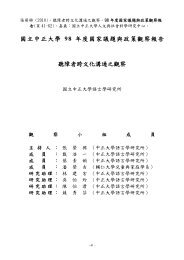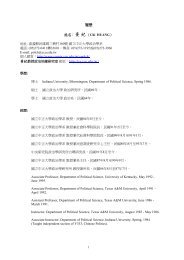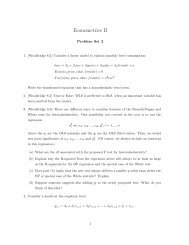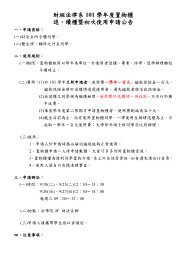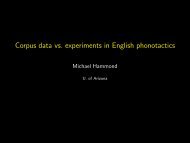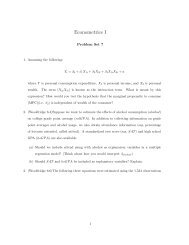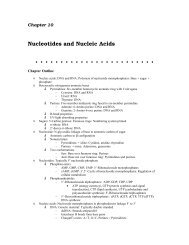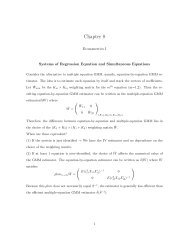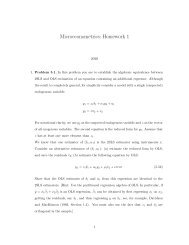Slides
Slides
Slides
Create successful ePaper yourself
Turn your PDF publications into a flip-book with our unique Google optimized e-Paper software.
"The acquisition of syntactic categories in Chinese:<br />
issues of bootstrapping and productivity" *<br />
Thomas Hun-tak Lee, Chinese University of Hong Kong<br />
Email: huntaklee@cuhk.edu.hk<br />
International Workshop on Grammar & Evidence<br />
National Chung Cheng University, Taiwan<br />
April 13-15, 2007<br />
1. Two contrasting positions on the acquisition of syntactic categories<br />
1.1 The nativist position: the Universal Category Hypothesis (Chomsky 1965,<br />
1970, Jackendoff 1977, Wexler and Culicover 1980)<br />
The nativist position as enunciated in Chomsky (1965), termed the Universal<br />
Category Hypothesis by Culicover (1999), assumes that syntactic categories such as<br />
nouns, verbs, adjectives and prepositions are drawn from the substantive universals of<br />
Universal Grammar, understood to be part of the initial state of the child. These<br />
categorial primitives can be further analyzed as features within the framework of<br />
X-bar theory (Chomsky 1970, Jackendoff 1977, Baker 2003) .<br />
Given language variation, what is hardwired are just the formal category labels, and<br />
not the particular cluster of properties that define them. To bootstrap into the syntax of<br />
their target language, children must figure out the distributional characteristics of the<br />
various syntactic categories of the language.<br />
This boostrapping task could not be accomplished without some built-in biases, such<br />
as the learner's assuming canonical mappings between syntactic categories and the<br />
prototypical meanings of their members, as postulated in the Semantic Bootstrapping<br />
Hypothesis of Pinker (1987).<br />
1.2 The empiricist position: the Contingent Category Hypothesis (Braine 1963,<br />
Bowerman 1976, Maratsos and Chalkley 1980, Culicover 1999, Tomasello 2003)<br />
The empiricist hypothesis on category acquisition, termed the Contingent Category<br />
Hypothesis by Culicover (1999), does not assume innately given syntactic primitives.<br />
Children learn the distributional characteristics of various syntactic categories<br />
inductively, using information such as morphological marking, word order and<br />
semantic/ conceptual primitives.<br />
*<br />
I am indebted to various members of the Hunan Chinese Early Language Acquisition group who contributed to<br />
the recording of the data of two subjects: LSY and AJR, and the transcription of the recordings: Ai Zhaoyang,<br />
Zeng Tao, Huang Aijun, Chen Min, Cai Xin, Chen Feiyan, Liao Hui, Xiao Ling and Yang Jie. Thanks are also due<br />
to Wang Hao for his technical support in the data processing for distributional analysis. We owe special thanks to<br />
Ning Chunyan for his staunch support of acquisition research at Hunan University. The research reported in this<br />
paper was supported by two grants to Thomas Lee, a Research Grants Council grant (CityU 1245/02H), and a<br />
faculty start-up grant of the Chinese University of Hong Kong.<br />
1
In theory, language could vary without limit in the way word classes are formed and<br />
in the features utilized to encode the category. A language may have major categories<br />
with a large membership, such as nouns and verbs, as well as idiosyncratic minor<br />
categories or sub-categories consisting of very few members. The set of syntactic<br />
categories in human language is potentially unbounded.<br />
Empiricist views on the acquisition of syntactic categories have had a long history,<br />
going back to the early pivot grammar of Braine (1963), the limited scope forumulas<br />
of Braine (1976), the semantic-based proposals of Bowerman (1973) and Schlesinger<br />
(1982), the semantic-distributional analysis of Maratsos and Chalkley (1980),<br />
Maratsos (1982), the inductive learning account of MacWhinney (1982) that takes<br />
into account the function of rote-learning, analogy and item-based patterns; and the<br />
more recent usage-based proposal of Tomasello (1992, 2000, 2003) which argue for<br />
the predominance of lexically based patterns rather than abstract categories in early<br />
development.<br />
Very Early Parameter Setting (VEPS): "From the earliest observable ages (around<br />
18 months), children have set their parameters correctly." (Wexler 1998, 2003)<br />
'Do young children have adult syntactic competence" (Tomasello 2000):<br />
"...the 2-year-old child's syntactic competence is comprised totally of verb-specific<br />
constructions with open nominal slots. Other than the categorization of nominals,<br />
nascent language learners possess no other linguistic abstractions or forms of<br />
syntactic organization." (Tomasello 2000:214)<br />
1.3. Arguments in favor of the Universal Category Hypothesis<br />
• Inherent circularity in the definition of syntactic categories (cf. Pinker 1987).<br />
Criteria for the English determiner (Valian 1986):<br />
a) Must appear, if present in NP, pre-Adj or pre-Noun or pre-both.<br />
b) Must not stand alone as sole content of an utterance or phrase.<br />
c) Must not be sequenced (exceptions: certain quantifiers).<br />
Criteria for the Cantonese classifier (Wong 1998:58)<br />
a) A classifier can occur immediately after a determiner, a numeral, or a VP.<br />
b) A classifier usually occurs immediately before a noun or an adjective modifying the<br />
head noun.<br />
c) A classifier can occur immediately before an adjectival phrase or relative clause.<br />
• A purely item-based distributional account will involve astronomical computations<br />
Caveat: The learner may not consider all combinations of words out of other<br />
constraints such as processing limitations; the idea of 'less is more' of Elissa Newport<br />
2
(1990). The computations will be reduced if frequency effects are taken into<br />
consideration (Mintz, Newport and Bever 1995; Mintz 2003).<br />
• UG principles make reference to syntactic categories (Lasnik 1990)<br />
• The early acquisition of functional categories and core syntactic structures in early<br />
child language. The issue of continuity in language development.<br />
Knowledge of inflectional categories by two years of age (Poeppel and Wexler 1993,<br />
Wexler 1998, 2003; Pierce 1992; Deprez and Pierce 1993).<br />
Knowledge of structure-dependence by three years old (Crain and Nakayama 1987)<br />
Knowledge of numerous subtle properties of grammar (Constraints on<br />
wanna-contraction, and Principle A and Principle C of the Binding Theory)<br />
(see Crain 1991, Crain and Thornton 1998 for a review of relevant studies; also Chien<br />
and Wexler 1987, 1990).<br />
2. What counts as evidence for category acquisition<br />
Typically the advocates of UCH and CCH do not use the same criteria for category<br />
acquisition, or the same kinds of data, and often ignore the crucial evidence produced<br />
by the other side.<br />
Tomasello (2000).<br />
Crain vs Tomasello debate at BU Conference on Language Development (2004).<br />
Linguists do not have a consensus on the kinds of criteria that count as decisive<br />
evidence for children's knowledge of syntactic categories.<br />
2.1 Observance of category distribution in adult language<br />
Table 1. Determiner use by two-year-old English children (Valian 1986)<br />
Child Age MLU Utterances Tokens *post-adj *alone *two<br />
/utterance or<br />
Dets in<br />
*post-N<br />
sequence<br />
A 2;0 2.93 420 .36 0 0 0<br />
D 2;3 3.21 532 .50 0 0 1<br />
I 2;5 3.31 200 .37 0 0 0<br />
S 2;5 3.47 689 .30 0 0 0<br />
E 2;5 3.58 358 .36 0 0 0<br />
N 2;0 4.14 52 .42 0 0 0<br />
Example 1: Determiners in English (Valian 1986)<br />
3
A study of 6 English-speaking children aged between 2 years and 2 years 5 months,<br />
with MLU ranging from 2.93 to 4.14.<br />
Example 2: Modal auxiliaries in English (Valian 1991)<br />
A study of 21 American children aged between 1;10 and 2;8, divided into 4 age<br />
groups, the youngest group having the mean age of 2;0 and mean MLU 1.77, and the<br />
oldest group having the mean age of 2;7 and MLU 4.22.<br />
All children except the lowest MLU child produced modal auxiliaries. In every group,<br />
'can' and 'll/will' were the two most common modals.<br />
Modal usage was infrequent: in Group I, only 3% of utterances with verbs contained<br />
modals, a total of 14 tokens. There was a steady gradual increase to 6% in Group II<br />
(61 tokens), 9% in Group III, and 14% in Group IV.<br />
Valian argued that Group I children have knowledge of modals as a category separate<br />
from verbs, ie. knowledge of INFL.<br />
"First appearance correlates highly with more stringent criteria...Sampling<br />
considerations alone would suggest that a child has been using a form before our data<br />
demonstrate it. ....At present any criterion beyond initial correct use appears arbitrary.<br />
Since the Group I children made no distributional errors with the modals they used,<br />
we have called their use genuine." (p. 60)<br />
Example 3: Finite vs nonfinite distinction of verbs in Dutch<br />
Table 2. Verb use by Dutch children (aged 1;7-3;7; N=47) (Wexler 2003)<br />
All normal children V2 Vfinal<br />
Finite 1953 (99%) 11 (2%)<br />
Non-finite 20 (1%) 606 (98%)<br />
"Very little leeway has to be given to measurement error or noise, even at the<br />
youngest ages. This is the kind of data that psychologists studying cognitive<br />
development almost never see, close to categorical data." (Wexler 2003)<br />
2.2 Pre-requisite for distributional analysis: demonstrating the productivity of<br />
early word combinations<br />
How to analyze a multiword utterance W1 W2<br />
(a) W 1+2<br />
(frozen form)<br />
(b) W1+W2<br />
(genuine word combination)<br />
(c) Category1 + Category2 (category sequence)<br />
4
Explicit coding scheme for measuring productivity of multiword utterances:(Lieven,<br />
Pine and Barnes 1992, Lieven, Pine and Baldwin 1997).<br />
Frozen phrases: utterances which contain two or more words which have not<br />
previously occurred alone in the child's vocabulary or which contain one such word,<br />
provided it has not occurred in the same position in a previous multi-word utterance.<br />
Constructed utterances: utterances which contain one or more words or phrases which<br />
have occurred independently in the child's vocabulary together with a word or phrase<br />
which has occurred in the same position in at least two other previous multi-word<br />
utterances.<br />
Example:<br />
Words in child's single-word vocabulary:<br />
Gone<br />
ball<br />
dolly<br />
birdie<br />
dinner<br />
Multi-word utterances:<br />
book gone<br />
ball gone<br />
dolly gone<br />
birdie gone<br />
dinner gone<br />
frozen phrase<br />
intermediate<br />
constructed<br />
constructed<br />
constructed<br />
Lexically-based constructions can account for about 60% of children's early<br />
multi-word utterances, with the remainder 40% consisting primarily of frozen phrases<br />
(Lieven, Pine and Baldwin 1997).<br />
Acquiring a stock of frozen phrases may be a typical route for syntactic acquisition<br />
(Pine and Lieven 1993).<br />
2.3 Variety of category membership ('Multiple appearances' test)<br />
There should be multiple members, and each of the members should occur in a range<br />
of diagnostic contexts.<br />
Example 1: V + tense/aspect (Pine, Lieven and Rowland 1998)<br />
A study of 12 children audiorecorded at monthly to fortnightly intervals for about six<br />
months. The age at the beginning of the recording varied between 1;3 and 2;0. The<br />
age at the end of the recording varied between 1;10 and 2;7.<br />
5
Table 3. No. of verb types before inflections<br />
(Pine, Lieven and Rowland 1998)<br />
Subjects -ing -s -ed<br />
Rita 17 2 4<br />
Joey 32 5 8<br />
Julie 12 2 3<br />
Jean 30 2 4<br />
Ricky 8 2 1<br />
Eva 11 8 2<br />
Helen 4 2 -<br />
Carl 11 - -<br />
John 1 1 1<br />
Simon 22 - 2<br />
Olga 7 - -<br />
Laura 4 - 1<br />
Mean 13.3 2.0 2.2<br />
Example 2 : V + CP (Diessel 2004)<br />
A study of CHILDES data of five children covering the age range 1;7 to 5;1.<br />
For all five children (Naomi, Peter, Nina, Sarah, Adam) the most frequent<br />
complement taking verbs of the children's finite complement clauses are the following,<br />
which constituted 80% of the tokens:<br />
know, see, think, say, look (mean %: 22.9, 20.5, 19.0, 9.8, 8.8).<br />
(I) think it's a cow. [Peter 2;2]<br />
Know what that is [Nina 2;3]<br />
Let's see if we can fix them. [Peter 2;3]<br />
Diessel argues that most utterances that include a finite complement clause in early<br />
child speech are simple nonembedded sentences containing a single proposition.<br />
These 'matrix verbs' are epistemic markers, attention getters or markers of<br />
illocutionary force.<br />
2.4 Combinatorial versatility<br />
There should be a certain degree of overlap in the cooccurrence patterns of various<br />
members of the category.<br />
Example: Aux + V (Pine, Lieven and Rowland 1998)<br />
6
None of the children showed overlap that was significantly different from zero on any<br />
of the overlap measures. Pine et al argue against postulating modal auxiliaries for<br />
children of this age range.<br />
Table 4. Proportion of verbs that occurred with both auxiliaries to verbs<br />
that occurred with either (Pine, Lieven and Rowland 1998)<br />
Subjects can/do can/be can/have do/be do/have be/have<br />
Rita 2/10 1/10 1/10 1/4 1/4 1/3<br />
Joey 0/10 0/15 1/5 0/17 0/8 0/13<br />
Julie 0/8 0/9 1/9 0/7 0/8 2/7<br />
Jean 2/20 3/19 0/14 4/22* 1/17 2/16<br />
Ricky 1/9 0/7 1/6 0/9 1/8 0/6<br />
Eva 1/11 1/9 0/6 2/14 0/12 1/9<br />
Helen 0/4 1/3 0/4 0/6 1/5 0/6<br />
Carl 0/3 0/7 0/3 1/5 1/1 1/5<br />
John 0/3 0/2 0/5 0/1 0/4 0/3<br />
Simon 0/7 1/7 2/5 0/7 0/6 1/6<br />
Olga 0/2 0/2 0/2 0/2 0/2 0/2<br />
Laura 0/1 0/3 0/1 0/4 0/2 1/3<br />
*Indicates an overlap score significantly different from zero at p
Substitution: 'drink water' > 'drink milk'.<br />
Expansion: 'lock-it' > 'lock that Lulu'.<br />
Addition: 'hit tennis' > 'Danny hit tennis';<br />
Coordination: 'Maria hit. Hit me.' > 'Maria hit me'.<br />
Based on data from his daughter for the period 18 to 20 months, Tomasello (1992:<br />
236-7) reports that 92% of the first 271 three-or-more-word combinations of the child<br />
involved only a single simple change from previous sentences with the same verb.<br />
Reordering of elements in a sentence is a rare operation.<br />
3. Data from Chinese-speaking children<br />
3.1 Productivity of early word combinations in Cantonese-speaking children (Lee<br />
2004)<br />
Table 5. Multi-word combinations of two Cantonese-speaking children before 2;0<br />
Child Age frozen phrases intermediate<br />
utterances<br />
constructed<br />
utterances<br />
MHZ 1;7-2;0 55 (23%) 109 (45%) 77 (32%) 241<br />
CKT 1;5-2;0 77 (21%) 69 (19%) 218 (60%) 364<br />
total number<br />
of<br />
multi-word<br />
utterances<br />
Lieven's methodology is too restrictive in excluding first time occurrences as<br />
indicative of productive patterns.<br />
For example, if a child says Daddy drink and drink milk, and later says Daddy drink<br />
milk, the latter utterance will not be classified as constructed. But the child may be<br />
generalizing from its knowledge of subject-predicate and verb-object structures (cf.<br />
McNeill 1966).<br />
3.2 Verb as a category (shown by its being an argument of a higher predicate)<br />
(Xiao, Cai and Lee 2006)<br />
Table 6. Longitudinal data for verb argument analysis and distributional analysis<br />
Subject Age range covered Number<br />
of<br />
sessions<br />
Age range<br />
covered<br />
AJR 01;02;22-02;00;26 20 01;06;03-02;00;10 13<br />
LSY 01;03;14-02;00;19 20 01;06;28-01;11;29 11<br />
Number<br />
of<br />
sessions<br />
8
Table 7. Number of verbs occurring in negative sentences, in sentences with verb<br />
complements and in [V V] compounds*<br />
Subject # of verbs # of verbs # of verbs # of verbs # and<br />
(types, (types) (types) (types) percentage<br />
including occurring occurring as occurring as V2 of verbs<br />
adjectives) in negative complements in [V1 V2] (types)<br />
utterances to matrix verbs compounds, (# occurring as<br />
(including of those V2 argument of<br />
existential, which also other<br />
modal and occurred as operator<br />
aspectual<br />
verbs)<br />
independent<br />
predicates)<br />
AJR 134 24 28 18 (13) 61 (45.5%)<br />
LSY 170 52 25 29 (20) 87 (51.2%)<br />
*Examples of different types of sentences are as follows: negative utterance: buyao (not want),<br />
meiyou qu (not go); verb complements: hui hua (can draw), yao mama lai (want mommy<br />
come), you wenzi guo (exist mosquito pass) , qu wan (go play); [V V] compounds in which<br />
the second verb was also used independently: qie-kai (cut-open); na-xialai (take-down),<br />
da-po (beat-broken).<br />
The data show clearly that both children used verbs as a semantic argument of the<br />
negator, existential, modal and aspectual verbs, as well as other matrix verbs.<br />
3.3 The feasibility of distributional bootstrapping for verbs (Cai 2006, Xiao, Cai<br />
and Lee 2006)<br />
We analyzed adult input to the two Mandarin-acquiring children from around 1 year 2<br />
months to 2 years of age, following the method of Mintz (2003). We extracted every<br />
sequence of three adjoining words from each utterance. In each such sequence, the<br />
intervening word was the target and the neighboring words were considered as the<br />
frame, i.e. the linguistic environment of the target word.<br />
The frequency of each frame, as well as that of each intervening word in the frames,<br />
was recorded. In this analysis, a subset of all frames whose frequency reached 15 or<br />
more were considered as frequent frames. With respect to frames in children’s<br />
production, those whose frequency reached 3 or more were considered as frequent<br />
frames.<br />
The intervening words of each frequent frame were assigned category labels<br />
according to the linguistic criteria for word classes in Mandarin Chinese. To compute<br />
the accuracy score for each frame, all possible pairs of words in the category were<br />
compared. Each pair was classified as a hit or false alarm. A hit was recorded when<br />
two words were from the same syntactic category. And a false alarm was recorded<br />
when two items were from different syntactic categories.<br />
9
Accuracy =<br />
hits +<br />
hits<br />
false<br />
alarms<br />
For each cluster of intervening words identified by a frame, the category label that<br />
occurred most frequently, in terms of both type and token, was taken as the prominent<br />
category of the frame. This measure indicates the degree to which a salient category<br />
was identified by a frequent frame.<br />
number of words belonging to pro min ent category<br />
Prominence=<br />
number of all words<br />
Table 8. Examples of frequent frames in the adult input to AJR (w_w)<br />
Frequent<br />
frames<br />
zenme_de<br />
“how_particle”<br />
Intervening words (number of tokens)<br />
shuo “talk”(76), jiao “call”(17), gao “manage to get”(6),<br />
jiang “speak”(6), da “beat” (5), xi “wash”(4), chang “sing”<br />
(3), tiaowu “dance” (2), an “press”(1), cai “guess”(1), fang<br />
“put up”(1), jiao “teach” (1), na “tale”(1), sukou “rinse<br />
one’s mouth” (1), shuijiaojiao “sleep”(1), xiang “ring”(1),<br />
xie “write”(1), zhidao “know”(1).<br />
Prominent<br />
category of<br />
intervening words<br />
verb<br />
bu_le<br />
“not_particle”<br />
yao “want to have”(8),wan “play(5), qu “go” (3), tiaowu<br />
“dance”(3), xi “wash”(3), tiao “jump”(3), hua “draw”(2),<br />
jide “remember”(2), jiang “speak”(2), jiao “call”(2), kai<br />
“open”(2), yun “dizzy”(2), ying “win”(2), ren<br />
“recognize”(1), shua “wash”(1), ting “listen”(1), tou<br />
“cast”(1), xihan “like”(1), zhong “hit target”(1), zhuan<br />
“turn” (1), zuo “sit”(1), guang “take charge of “(1), hao<br />
“good” (1), he “drink”(1), kan “look”(1), lai “come”(1).<br />
verb<br />
Table 9. Accuracy and prominence score of frequent frames in the adult input (types)<br />
Subject<br />
AJR<br />
Prominent<br />
category<br />
yielded by<br />
frequent<br />
frames<br />
Mean accuracy<br />
score of frequent<br />
frames (w_w)<br />
yielding verb and<br />
adjective<br />
Verb 0.74 0.91<br />
Adjective 0.77 0.88<br />
Mean prominence<br />
score of frequent<br />
frames yielding<br />
verb and adjective<br />
LSY<br />
Verb 0.83 0.86<br />
Adjective 0.82 0.89<br />
83-84% of the frequent frames produced by the two children at two years of age<br />
overlapped with the frequent frames of the adult input covering the period prior to two<br />
years of age.<br />
10
The frequent frame analysis of the adult input to these two children and the<br />
spontaneous utterances produced by the children indicate clearly the formation of<br />
distributionally defined word classes, and that distribuional bootstrapping of syntactic<br />
categories is possible.<br />
3.4 Syntactic development is not gradual or piecemeal (Xiao 2006, Xiao, Cai and<br />
Lee 2006)<br />
Only between 47 and 52 percent of the sentence frames first used with a verb<br />
involved repetition of a previous sentence frame or a single operation.<br />
Between 48 and 53 percent of the sentence frames first used with a verb involved two<br />
or more changes from prior sentence frames used with the verb, or were frames that<br />
could not be traced to any previous sentence frames for the verb. These figures are<br />
much higher than the 8% reported by Tomasello for his subject.<br />
Children were in command of sentence frames as abstract structures and were able to<br />
apply structures acquired for a particular verb to other verbs.<br />
Table 10. Changes in the sentence frames of verbs in verb chains<br />
for utterances with three or more words<br />
Number of changes from previous AJR LSY<br />
sentence in the same verb chain<br />
Repetition of previous sentence in the 56 66<br />
same verb chain<br />
One change from previous sentence 73 75<br />
in the same verb chain<br />
Subtotal 129 (51.8%) 141 (47.2%)<br />
Two changes from previous sentence 56 53<br />
in the same verb chain<br />
Three or more changes from previous 18 52<br />
sentence in the same verb chain<br />
No previous sentence in the same 46 53<br />
verb chain<br />
Subtotal 120 (48.2%) 158 (52.8%)<br />
(i) LSY: hongse bi mei hua qiangshang (01;10;10)<br />
Red pen not draw wall<br />
"(I) did not use the red pen to draw on the wall"<br />
(ii) LSY hua dabing (01;07;11)<br />
draw biscuit<br />
"Draw biscuit"<br />
11
LSY hua zhege bi (01;08;16)<br />
draw this pen<br />
"Draw with this pen"<br />
(iii) Step 1: Reordering : [_ Instrument] →[Instrument _ ]<br />
Step 2: Addition: [Instrument _ ] → [Instrument Neg _ ]<br />
Step 3: Coordination: [Instrument Neg _ ] + [ _ Location]<br />
→ [Instrument Neg _ Location]<br />
Reordering was a salient operation. LSY rearranged the positions of two constituents<br />
21 times, in sentences containing verbs such as kan ("look"), kanjian ("see"), hua<br />
("draw"), nian ("read") and pa ("fear").<br />
First-use verbs occurred in first-use frames rather than prior-use frames for about<br />
40-50% of the time.<br />
4. Assessing the discrepancies in the empirical findings<br />
4.1 The arbitrariness of criteria<br />
Are the criteria reasonable, even for adults (cf. production of sentence final particles<br />
or relative clauses in a Chinese adult)<br />
Why limit ourselves to naturalistic production data How about comprehension data<br />
The requirements of diversity of membership and combinatorial versatility may be<br />
overly stringent. Assessment of Diessel (2004)'s findings.<br />
4.2 Accounting for cross-linguistic differences<br />
Early development of inflectional features is not observed for English, because the<br />
morphemes that mark tense, person and number are not phonologically salient.<br />
Early development of inflectional features is observed for German, Dutch, French<br />
because of word order reflexes of inflectional features.<br />
Early emergence of the verb category in Chinese, reflected in verb argument<br />
structures and in the viability of distributional bootstrapping in word class acquisition,<br />
could have been facilitated by the prominence of V in reduplication structures and the<br />
syllabic form of aspectual markers.<br />
12
4.3 Individual variation<br />
How should we reconcile the patterns found in different data sets<br />
Theory shapes what one admits as relevant evidence.<br />
If one is interested in properties of the initial state, then individual variation will not<br />
be an issue of great interest.<br />
Just as it is possible to demonstrate language universals through observing one<br />
language, it is possible to demonstrate the nature of early syntactic competence<br />
through observing one child (Crain and Wexler 1999).<br />
If one would like to understand individual differences in language development, and<br />
understand the relationship between language development and cognitive<br />
development, the factors underlying varying rates of syntactic growth are clearly<br />
worthy of further exploration.<br />
5. Conclusions<br />
Some intractable problems remain for the empiricist view on category acquisition.<br />
Six types of criteria have been used in determining early vs. late emergence of<br />
syntactic categories.<br />
Four sets of Chinese child language data based on empiricist methodology have<br />
shown that:<br />
(a) Children's early word combinations are much more productive than is suggested<br />
by usage-based linguists;<br />
(b) The verb category is available to children before 2;0, since it often appears as an<br />
argument of another operator (in negative sentences, verb compounds, and verb<br />
complementation);<br />
(c) Distributional bootstrapping is a viable route for children to tap into the<br />
language-specific properties of particular word classes;<br />
(d) Early syntactic development is not gradual or piecemeal.<br />
13
References<br />
Bloom, P. (1990) “Syntactic distinctions in child language”, Journal of Child Language 17:<br />
343-355.<br />
Bowerman, M. 1973. "Structural relationships in children's utterances: syntactic or semantic",<br />
in T. Moore. ed. Cognitive Development and the Acquisition of Language. New York:<br />
Academic Press. Reprinted in L. Bloom ed. 1978. Readings in Language Development.<br />
New York: John Wiley.<br />
Braine, M. 1963. "The ontogeny of English phrase structure: the first phase", Language 39:<br />
1-13.<br />
Braine, M. 1976. Children's first word combinations. Monographs of the Society for research<br />
in child development vol. 41, no.1.<br />
Cai, Xin (2006) The acquisition of syntactic categories in Chinese on the basis of<br />
distributional information. MA thesis, Dept of Linguistics, Hunan University.<br />
Chien, Yu-chin and K. Wexler 1987. "A comparison between Chinese-speaking and<br />
English-speaking children's acquisition of reflexives and pronouns", paper presented at the<br />
1987 Boston University Conference on Language Development.<br />
Chien, Yu-chin and K. Wexler 1990. "Children's knowledge of locality conditions in binding<br />
as evidence for the modularity of syntax and pragmatics", Language Acquisition 1.3:<br />
225-295.<br />
Chomsky, N. 1965. Aspects of the Theory of Syntax. Cambridge, MA: MIT Press.<br />
Chomsky, N. (1970) "Remarks on nominalization", in R. Jacobs and P. Rosenbaum (eds.)<br />
Readings in English Transformational Grammar. Waltham, MA: Ginn.<br />
Crain, S. 1991. "Language acquisition in the absence of experience", Behavioral and Brain<br />
Sciences 14, reprinted in P. Bloom ed. 1994. Language Acquisition: core readings.<br />
Cambridge, MA: MIT Press.<br />
Crain, S. and M. Nakayama 1987. "Structure dependence in grammar formation", Language<br />
63: 522-43.<br />
Crain, S. and R. Thornton (1998) Investigations in Universal Grammar. Cambridge, MA: MIT<br />
Press.<br />
Crain, S. and K. Wexler (1999) "Methodology in the study of language acquisition: a modular<br />
approach," in W. C. Ritchie and T. K. Bhatia (eds.) Handbook of Language Acquisition.<br />
New York: Academic Press.<br />
Culicover, P. (1999) Syntactic Nuts: hard cases, syntactic theory and language acquisition.<br />
London: Oxford University Press.<br />
Deprez, V. and A. Pierce 1993. "Negation and functional projections in early grammar",<br />
Linguistic Inquiry 24.1: 47-85.<br />
Diessel, Holger (2004) The Acquisition of Complex Sentences. London: Cambridge<br />
University Press.<br />
Jackendoff, R. (1977) X-bar Syntax: a study of phrase structure. Cambridge, MA: MIT Press.<br />
Lasnik, H. (1990) "On certain substitutes for negative data," in Essays on Restrictiveness and<br />
Learnability. Dordrecht: Kluwer.<br />
Lee, T. (2004) "Productivity in the early word combinations of Cantonese-speaking children",<br />
in Shi Feng and Shen Zhongwei (eds) The Joy of Research ---A Festschrift in Honor of<br />
Professor William S-Y.Wang on His Seventieth Birthday. Tianjin: Nankai University<br />
Press. pp.38-58.<br />
Lee, T. and C. Wong (1998) "Cancorp-The Hong Kong Cantonese Child Language Corpus",<br />
Cahiers de Linguistique Asie Orientale vol. 27, no. 2, pp 211-228.<br />
Lieven, E., J. Pine and G. Baldwin (1997). "Lexically-based learning and early grammatical<br />
14
development", Journal of Child Language 24: 187-219.<br />
MacWhinney, B. (1982). "Basic syntactic processes", in S. Kuczaj III ed. Language<br />
Development Vol. 1: syntax and semantics. Hillsdale, NJ: Lawrence Erlbaum.<br />
Maratsos, Michael and M. Chalkley (1980) "The internal language of children's syntax: the<br />
ontogenesis and representation of syntactic categories," in K. Nelson (ed.) Children's<br />
Language. vol. 2. New York: Gardner Press.<br />
Mintz, Toben ( 2003) “Frequent frames as a cue for grammatical categories in child directed<br />
speech” Cognition 90 (2003) 91-117.<br />
Mintz, Toben, Elissa Newport, and Thomas Bever (1995) "Distributional regularities of form<br />
class in speech to young children," in J. Beckman (ed) Proceedings of the North East<br />
Linguistics Society 25 (vol. 2): 43-54. Amherst, MA: GSLA.<br />
Newport, Elissa (1990) "Maturational constraints on language learning", in Paul Bloom (ed)<br />
1993. Language Acquisition: core readings. Cambridge, MA: MIT Press. pp. 543-560.<br />
Pine, J. and E. Lieven (1993). "Reanalyzing rote-learned phrases: individual differences in the<br />
transition to multi-word speech", Journal of Child Language 20: 551-571.<br />
Pine, J., E. Lieven and C. Rowland (1998) "Comparing different models of the development<br />
of the English verb category," Linguistics 36.4: 807-830.<br />
Pinker, S. (1987). “The boostrapping problem in language acquisition”, in B. MacWhinney<br />
(ed) Mechanisms of Language Acquisition. Hillsdale, NJ: Lawrence Erlbaum.<br />
Poeppel, D. and K. Wexler (1993). "The full competence hypothesis of clause structure in<br />
early German", Language 69.1: 365-424.<br />
Schlesinger, I. (1982) "Semantic assimilation in the development of relational categories," in<br />
W. Deutsche (ed.) The Child's Construction of Language. New York: Academic Press.<br />
Tomasello, M. (1992). First Verbs: a case study of early grammatical development. London:<br />
Cambridge University Press.<br />
Tomasello, M. (2000a). "Do young children have adult syntactic competence" Cognition 74:<br />
209-253.<br />
Tomasello, Michael (2003) Constructing a Language-a usage-based theory of language<br />
acquisition. Cambridge, Massachusetts: Harvard University Press.<br />
Valian, V. (1986) “Syntactic categories in the speech of young children”, Developmental<br />
Psychology 22.4: 562-579.<br />
Valian, V. (1991) "Syntactic subjects in the early speech of American and Italian children,"<br />
Cognition 40: 21-81.<br />
Wexler, K. (1993) "Optional infinitives, head movement and the economy of derivations", in<br />
N. Hornstein and D. Lightfoot (eds) Verb Movement. Cambridge University Press.<br />
Wexler, Kenneth (1998) "Very early parameter setting and the unique checking constraint: a<br />
new explanation of the optional infinitive stage," Lingua 106: 23-79.<br />
Wexler, Kenneth (2003) "Lenneberg's dream: learning, normal language development, and<br />
specific language impairment," in Y. Levy and J. Schaeffer (eds.) Language Competence<br />
Across Populations: Toward a Definition of Specific Language Impairment. Mahwah, NJ:<br />
Lawrence Erlbaum.<br />
Wong, Sin Ping (1998) "The Acquisition of Cantonese Noun Phrases". PhD dissertation,<br />
University of Hawaii.<br />
Xiao, Ling (2006) Category and Productivity in the Early Development of Verb Argument<br />
Structures in Chinese. MA thesis, Dept of Linguistics, Hunan University.<br />
Xiao, Ling, Xin Cai, and T. Lee (2006) "The development of the verb category and verb<br />
argument structure in children before two years of age," in Yukio Otsu (ed.) Proceedings<br />
of the Seventh Tokyo Conference on Psycholinguistics. Tokyo: Hituzi Syobo.<br />
15




